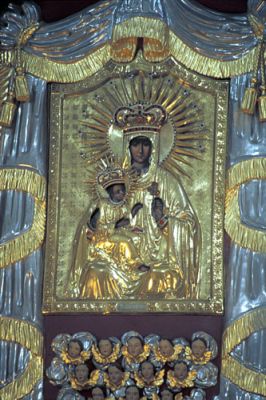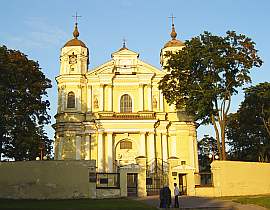Our Lady of Trakai
Our Lady of Trakai
A History of "Our Lady of Trakai"
– Reverend Anthony Markus

In 1409, Vytautas built a church in his native Trakai in honor of the Visitation of Mary (feast was July 2, now is May 31). This church became famous for its portrait of Mary and Jesus, which tradition says was donated by Vytautas himself. The icon was given to him by the Emperor of Constantinople, Manuel Paeleologus II, as a present for becoming Christian. Legend says that this same icon was brought to Constantinople by the Emperor John II Comnenus, in 1118, after the defeat of the Persians
In Trakai, this picture soon became well-known for its miracles. This icon of the Mother of God is said to be the first and the oldest known in Lithuania for its miracles. Within forty years, many votives offeringsIn (medallions, hearts and body parts in silver) from grateful people covered the walls where the picture hung. Some miracles have been recorded; in 1645, the pastor then, Simonas Mankevicius announced that twenty-three miracles were attributed to the miraculous Madonna.
One miracle happened in 1643; a small boy drowned in Lake Galva, and the parents brought the child's body to the altar of the Madonna. Miraculously, the boy revived.
Reports of miracles at the church soon spread to White(Belanus) Russia, Ukraine and Prussia. Pilgrims soon started to appear from distant countries, seeking health for body and soul.
The title of "Protectress of Lithuania" was given to Our Lady of Trakai when, through her intercession, people survived a plague in 1603. Processions would be planned yearly from Vilnius to Trakai to seek intervention from the Mother of God.
During the war with Moscow in 1611, Queen Konstancija came to the Shrine to pray to Our Lady for King Zigmantas Vaza's safety and victory over the Russians. Victory ensued!
It is very interesting that in 1629, Bishop Eustachijus Valavicius wrote in his report to the Holy See, that "God has favored us with many miraculous portraits in Lithuania of Our Lady, but the many miracles at the Shrine of Our Lady of Trakai brought many people closer to each other and to their God."
In 1718, the bishop of Vilnius, Konstantinas Brzostovskis, decided to pay homage and have the icon of Mary and Jesus crowned with the blessings of the Vatican. In 1717, the crown for the Lady's head was donated by the Lithuanian Chancellor, Leonas Sapiga, and the crown for the Infant's head was given by the Lithuanian vice-chancellor, Aleksandras Narusevicius.
When the portrait of Our Lady of the Gate of Dawn became famous, the Trakai icon began to be forgotten, though the records show that the miracles never ceased. A book recording the miracles was written in Polish; forty-two miracles were recorded from 1783 on. One example in the twentieth century happened on February 15, 1902. The mayor of Trakai, Konstantinas Pradevicius and his wife, Emilija, claimed that their daughter recovered from an incurable illness, due to Our Lady's help. The girl had diphtheria and doctors said that death was imminent. The worried parents came to pray before the icon and their daughter was cured.

Art historians say the icon is a mixture of Byzantine and Western style. The original picture was rectangular, with a life-size Madonna sitting, but during the Baroque era (1600s) it was cut below the knees (of the Madonna) to its present size. In the icon, Mary is in a frontal position and is holding the twelve-year-old Christ Child with her right arm; in her left hand there is a thorn-less rose with three blossoms. This rose represents the Trinity; it's a rose that never wilts and has no thorns - the reason being that God draws us to himself, and this love does not fade, nor does it cause hurt. In this left hand Jesus holds the Gospel Book representing his life's mission while his right hand reaches out to the rose, because he is drawn to his Father's will through the Holy Spirit.
Various churches have reproductions of Our Lady of Trakai; Vilnius Cathedral, Varniai, to mention a few.
In Latvia, there is a holy site in Aglona. Here is also a copy of Our Lady of Trakai, brought there by the Lithuanian Dominicans of Trakai. In Chicago, on the North Side, the Latvian Catholics have a church dedicated to this particular Madonna.
I also have a personal copy of Our Lady of Trakai. What attracted me to that particular Madonna was, that it was a gift to Vytautas for his Baptism into the Faith, its Byzantine style, and what Bishop Eustachijus Valavicius wrote to Rome about this particular miraculous icon of Mary and Jesus, "Trakai Marija brought many people closer to each other and to God."
Images shown:
The icon of Our Lady of Trakai
St. Peter and Paul Church in Vilnius, Lithuania
All About Mary includes a variety of content, much of which reflects the expertise, interpretations and opinions of the individual authors and not necessarily of the Marian Library or the University of Dayton. Please share feedback or suggestions with marianlibrary@udayton.edu.
